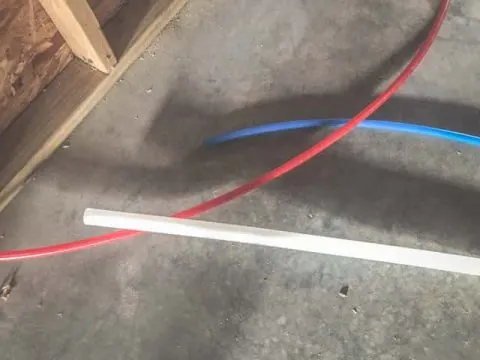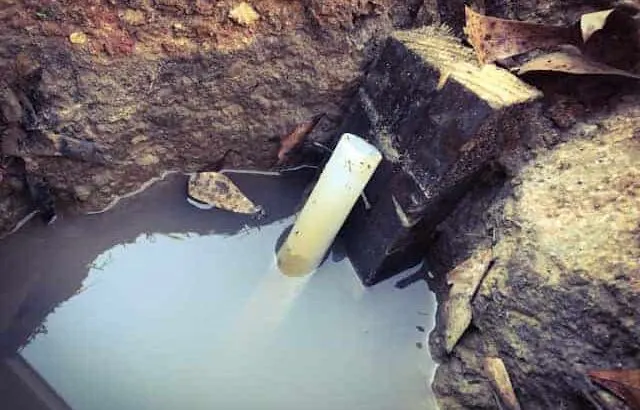Cross-linked polyethylene, also known as PEX, is a lightweight and durable polyethylene thermoplastic with cross-links. This tubing is typically used for domestic or building service pipes, hydronic systems, and insulation for electrical cables. Nowadays, PEX tubing is quickly replacing traditional copper and galvanized steel pipes and is an exceptional option for underground piping.
PEX tubing is approved for direct burial outdoors. PEX has a life expectancy of 40-50 years, made possible by its durable and non-corrosive materials. Burial also reduces sun exposure, which would otherwise degrade the piping. Additionally, PEX tubing materials allow for expansion, making them resistant to freezing/cracking underground.
My brother-in-law and I have used PEX tubing in our last three homes including buried line to the underground water main. There’s a few key things you need to understand so let’s dig into PEX tubing and fittings in terms of what type works best underground.
What Type of PEX Can be Buried?
Although you can generally bury PEX tubing, some tubing types will have a longer lifespan than others underground, especially when used to transport water in freezing conditions (source).
PEX-B is the first choice for burying due to its higher bursting pressure and reduced issues with leached chemicals.
Some individuals are wary of using any type of PEX tubing outdoors because it degrades under UV light. This means that if the tubing is exposed to the sun, it will break down much faster. Since PEX tubing isn’t the cheapest pipe option, costing anywhere between $1.75 and $7.50, a severely shortened lifespan is not ideal.
Luckily, because the PEX tubing is being buried in this scenario, it won’t degrade from UV light as long as you limit its exposure to the sun prior to installation. Embedding the tubing in the sand once it is buried can help prevent damage from rocks and soil. Bury the tubing below the frost line to prevent water from freezing in the pipes.

That being said, here are the three types of PEX tubing, two of which are ideal options for underground systems.
PEX-A
Compared to the other two PEX tubing options, PEX-A is manufactured using peroxide, and it is the most flexible and softest tubing with the highest degree of cross-linking for the strongest chemical bond. This is the second-best PEX tubing option for burial, behind PEX-B.
The benefits of using PEX-A tubing in this scenario are that it is a non-corrosive tubing as opposed to more common materials, such as copper or steel, which inhibits the likelihood of the PEX tubing leaking or contaminating the water supply.
Purchase PEX-A tubing online (link to Amazon).
However, PEX-A tubing is more likely to leech chemicals from the manufacturing process into the water supply than PEX-B, so be aware there is still some level of risk with this product (source).
PEX-A tubing is suitable for burial because its flexibility allows the tubing to expand, particularly when subjected to freezing water allowing a high degree of resistance to cracking in frigid temperatures.
Although the PEX-B tubing is not as flexible as PEX-A, it has a higher bursting pressure, which means, when exposed to colder temperatures, it will withstand these temperatures longer without bursting than the PEX-A.
Ultimately, PEX-A is much easier to work with and can moderately withstand freezing conditions when buried, but it is not the best choice for burial over the PEX-B tubing.
PEX-A tubing typically costs quite a bit more than PEX-B tubing at an average cost of $3.50 to $7.50 per 10-foot piece.
PEX-B
If you are truly set on burying a length of PEX tubing, you should opt for the PEX-B tubing as your primary choice. Not only is this the most affordable PEX tubing option with an average cost of $2.50 to $5.50 per 10-foot piece, but it also has all the benefits of the PEX-A tubing and few drawbacks.
We’ve already mentioned that the PEX-B tubing has a higher bursting pressure than PEX-A, which is optimal when burying tubing that might be subjected to freezing temperatures. In addition to its non-corrosive material and reduced chances of chemical leeching, this feature makes PEX-B a more suitable choice.
Purchase PEX-B tubing online (link to Amazon).
In terms of differences and drawbacks, PEX-B differs from PEX-A in that it is manufactured using a moisture-cure method. This tubing is much less flexible than PEX-A, rendering it more difficult to work with.
Additionally, if your PEX-B tubing gets a kink while underground, you will have to dig up the tubing, cut out the kinked section, and replace this section with additional tubing and fixtures.
With the PEX-A tubing, many people point out that you can skip this process by fixing the kink by applying heat although it’s not recommended due to the precise heating required (source).
Altogether, PEX-B tubing might be less flexible and has a lower cross-link ratio than PEX-A, for the purposes of burying the tubing, its increased bursting pressure and cost-effective pricing make it the best choice.
This YouTube video from Williams Plumbing and Heating gives an outstanding overview of the differences of PEX-A and PEX-B as well as covering the key advantages and disadvantages of each:
PEX-C
PEX-C is manufactured using an irradiation method and is ultimately not suitable for burial. It is, by far, the most difficult PEX tubing to work with because it is incredibly stiff. This means the tubing is more prone to kinking and cracking when exposed to freezing conditions.
Since the goal is to bury the tubing, using PEX-C would most likely require frequent repairs due to damage and bursting.
The sole benefit of PEX-C tubing is that it is the cheapest option, with an average cost of $1.75 to $3.50 per 10-foot piece. However, the amount you would spend on repairs if you used this tubing would significantly outweigh what you saved purchasing PEX-C over PEX-B.
Ultimately, if you want to use PEX-C, it is best suited for short repairs where you need a straight and sturdy pipe, not for lengthy underground piping.
| PEX-A | PEX-B | PEX-C | |
|---|---|---|---|
| Pro | Highest Flexibility | Highest bursting pressure | Most environmentally friendly |
| Con | Potential for chemical leaching | Stiff and prone to coil memory | Prone to cracks |
| Suitable for Underground | Yes | Yes | No |
Can PEX Crimp Fittings be Used Underground?
PEX-A and PEX-B tubing are both exceptional options for underground piping. However, these pipes’ effectiveness means very little if the fittings used cannot withstand the same conditions.
Crimp fittings are a popular option when installing piping, but they are not optimal for underground piping.
There are two common PEX fittings, clamps and crimps. The PEX crimps are often made of copper, which is the primary reason they are not conducive to burial.
The biggest concern when burying tubing and fittings is how extreme temperatures, particularly freezing conditions, affect their overall functionality.
In the case of copper PEX crimps, a common occurrence when exposed to freezing water is that it will cause the ring to expand, and then, over time as temperatures rise, this expansion will result in a leak.
Alternatively, the best PEX fitting for underground use is the stainless-steel clamp ring resistant to corrosion and more suitable for direct burial applications.
My brother-in-law likes to plan out this process and prevent any joints underground that we can, thereby reducing the potential for issues.
Always remember that anywhere you are joining pipe with fittings you are introducing a potential point of failure. Keeping those to a minimum in buried runs will reduce the opportunity for issues.
Can Sharkbite Fittings be Used Underground?
As opposed to PEX crimp fittings, Sharkbite fittings are suitable for burial as professed by the company and supported by The International Association of Plumbing and Mechanical Officials (source).
SharkBite uses a lead-free brass push-to-connect fitting with an EPDM O-ring and a stainless steel 316 grab ring. These materials ensure the fitting is durable, long-lasting, and won’t contaminate your water supply. The fitting is also compatible with a series of pipes, including PEX (source).
Although the material make-up of the fitting is beneficial to underground conditions, the real reason Sharkbite fittings are conducive to burial is that they are wrapped in silicone tape. Sharkbite guarantees the silicone tape won’t break down, and the fittings are wrapped in this material for two reasons.
- Protect the fitting from chemicals and soil contaminants.
- Helps ensure the company’s 25-year warranty.
The quality materials of the lead-free brass fitting and the added insurance of the silicone tape render these fittings an exceptional choice to accompany underground PEX tubing.
This YouTube video is a great overview of using Sharkbite fittings for buried PEX connections.
Final Thoughts
Initially, the PEX company had a bit of a rocky start with frequent product leakage complaints. Now, after significant product improvements, you can find PEX products in over 60 % of new construction residential water supply systems (source).
Both PEX-A and PEX-B tubing are exceptional choices for underground work and can be supported with stainless steel PEX clamps or Sharkbite Fittings.
The significant lifespan of PEX tubing ranging from 40-50 years in addition to its 25-year warranty (an offer that also applies to Sharkbite fittings) enhances the benefits of choosing these products over more traditional pipes for underground systems.
As a homeowner, I am constantly experimenting with making the structure of my house more energy-efficient, eliminating pests, and taking on DIY home improvement projects. Over the past two decades, my family has rehabbed houses and contracted new home builds and I’ve learned a lot along the way. I share my hard-learned lessons so that you can save time and money by not repeating my mistakes.


Leave a comment
You must be logged in to post a comment.